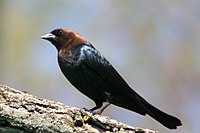
Photo from wikipedia
The behaviour of individual birds before and during the breeding period may be an important factor determining reproductive success. One commonly observed behaviour during the breeding period in many species… Click to show full abstract
The behaviour of individual birds before and during the breeding period may be an important factor determining reproductive success. One commonly observed behaviour during the breeding period in many species is the visitation of multiple potential breeding sites. Much research has attempted to determine the function and consequences of this behaviour, but traditionally studies have been limited to not examining individual‐level behaviour, or only considering a small number of individuals. We used automated recording of RFID‐tagged birds visiting nestboxes to study a population of 80 great tits (Parus major) making > 3500 daily visits across 74 breeding sites, to quantify the frequency, spatial patterning, and temporal occurrence of this behaviour from the pre‐breeding period onwards. We argue that 1) the tight spatial clustering of visits, 2) juveniles visiting more sites than adults, and 3) males (but not females) continuing to visit other sites even as egg laying at their own nest occurs, indicate that territoriality and extra‐pair mating may underpin visitation behaviour. Further, we find that spatial clustering of female visits relates to increased clutch size and fledging success, while frequently visiting a preferred nesting site increases the likelihood of obtaining a breeding site but reduces subsequent reproductive output for both sexes. Our study offers new insight into the mechanisms potentially driving breeding site visitation behaviour, and demonstrates its relationship to individual fitness. We suggest that although visitation behaviour may be related to different components of fitness, future work should use experiments to fully assess the causal factors and effects of visitation behaviour.
Journal Title: Journal of Avian Biology
Year Published: 2018
Link to full text (if available)
Share on Social Media: Sign Up to like & get
recommendations!